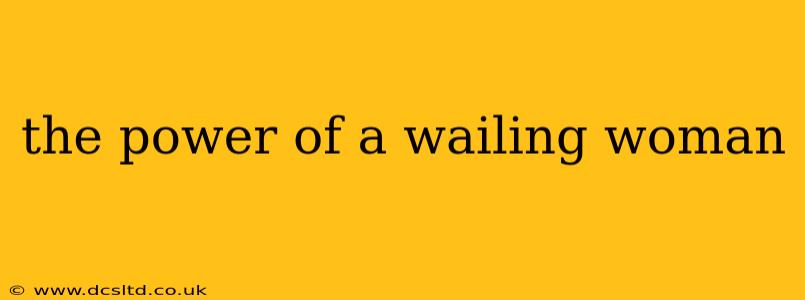The image of a wailing woman, often associated with grief and sorrow, holds a surprising depth of cultural significance and emotional power. While often stereotyped, the act of wailing—a loud, expressive cry—serves diverse purposes across various cultures and contexts. It's not simply uncontrolled emotion; it's a powerful form of communication, ritual, and even social action. This exploration delves into the multifaceted nature of wailing women, examining its historical roots, cultural interpretations, and the potent emotions it conveys.
What Does Wailing Mean in Different Cultures?
Wailing, or keening, as it's known in some cultures, isn't a universal expression with a single meaning. Its interpretation varies significantly depending on cultural context. In some societies, it’s a deeply ingrained ritualistic practice associated with funerals and mourning, a public display of grief meant to honor the deceased and help the community process loss. In other cultures, wailing might signify protest, expressing anger, injustice, or societal upheaval. The specific sounds, gestures, and accompanying actions all contribute to the nuanced meaning. For instance, the pitch, rhythm, and duration of the wail might convey different levels of intensity, ranging from quiet sorrow to intense anguish.
Why Do Women Often Wail?
The association of wailing with women is a widespread phenomenon across many cultures. Several factors contribute to this. Historically, women have often been relegated to the domestic sphere, charged with expressing the emotional burdens of the family and community. Wailing, then, becomes a socially acceptable outlet for expressing emotions considered less appropriate for men in certain patriarchal societies. Furthermore, the physical act of wailing, particularly the high-pitched cries, can be perceived as a more feminine expression of grief than other forms of mourning. However, it's crucial to note that this association is not universal, and in some contexts, men may also participate in forms of wailing or expressive crying.
Is Wailing a Sign of Weakness or Strength?
This question highlights a crucial misunderstanding surrounding wailing. Viewing it as a sign of weakness often stems from cultural biases that undervalue emotional expression, especially in women. In reality, wailing can be an act of immense strength. It requires vulnerability, courage, and the willingness to publicly display intense emotion in a society that may stigmatize such expressions. It's a powerful way to confront grief, to channel pain, and to connect with others who share similar experiences. It's a form of resistance against the suppression of emotion, a defiance of societal norms that often silence marginalized voices.
What are the Different Types of Wailing?
The forms of wailing vary widely depending on the specific culture and context. Some cultures involve highly stylized and ritualistic forms, with specific melodies, chants, and gestures. Others are more spontaneous and unrestrained. The accompaniment of instruments, the participation of the community, and the setting (e.g., a funeral, a protest) all influence the overall character of the wailing. The intensity, duration, and style can provide valuable insights into the emotional state of the wailer and the cultural significance of the event.
What is the Psychological Impact of Wailing?
The psychological impact of wailing is a subject of ongoing research, but it's clear that expressing intense emotions through vocalization can have a cathartic effect. For many, it can be a vital component of the grieving process, facilitating the release of pent-up emotions and fostering a sense of emotional release. This release can aid in the process of healing and coping with trauma. However, it's important to remember that individual experiences vary, and some may find other coping mechanisms more effective.
Conclusion: Understanding the Nuances of a Wailing Woman
The power of a wailing woman lies not in its simplicity, but in its complex tapestry of cultural meaning, emotional depth, and social significance. It's a potent form of expression that challenges societal norms, honors the dead, protests injustice, and provides a pathway for emotional healing. Understanding the nuances of wailing requires moving beyond simplistic interpretations and embracing the richness of diverse cultural practices. By recognizing the strength, resilience, and profound communication inherent in this act, we can gain a deeper appreciation for the complexities of human emotion and its varied forms of expression.
